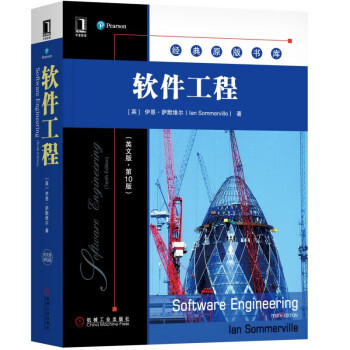软件工程(英文版·第10版) / 经典原版书库
¥129.00定价
作者: [英]伊恩·萨默维尔
出版时间:2017-10
出版社:机械工业出版社
- 机械工业出版社
- 9787111580966
- 10版
- 283893
- 47229819-9
- 平装
- 16开
- 2017-10
- 1092
- 780
- 工学
- 计算机科学与技术
- TP311.5
- 计算机通信类
- 本科
作者简介
内容简介
本书是软件工程领域的经典教材,自1982年第1版出版至今,伴随着软件工程学科的发展不断更新,影响了一代又一代的软件工程人才,对学科建设也产生了积极影响。全书共四个部分,完整讨论了软件工程各个阶段的内容,是软件工程相关专业本科生和研究生的教材,也是软件工程师必备的参考书籍。
目录
Part1 Introduction to Software Engineering 01
Chapter 1 Introduction 03
1.1 Professional software development 05
1.2 Software engineering ethics 14
1.3 Case studies 17
Chapter 2 Software processes 29
2.1 Software process models 31
2.2 Process activities 40
2.3 Coping with change 47
2.4 Process improvement 51
Chapter 3 Agile software development 58
3.1 Agile methods 61
3.2 Agile development techniques 63
3.3 Agile project management 70
3.4 Scaling agile methods 74
Chapter 4 Requirements engineering 87
4.1 Functional and non-functional requirements 91
4.2 Requirements engineering processes 97
4.3 Requirements elicitation 98
4.4 Requirements specification 106
4.5 Requirements validation 115
4.6 Requirements change 116
Chapter 5 System modeling 124
5.1 Context models 127
5.2 Interaction models 130
5.3 Structural models 135
5.4 Behavioral models 140
5.5 model-driven architecture 145
Chapter 6 Architectural design 153
6.1 Architectural design decisions 157
6.2 Architectural views 159
6.3 Architectural patterns 161
6.4 Application architectures 170
Chapter 7 Design and implementation 182
7.1 Object-oriented design using the UmL 184
7.2 Design patterns 195
7.3 Implementation issues 198
7.4 Open-source development 205
Chapter 8 Software testing 212
8.1 Development testing 217
8.2 Test-driven development 228
8.3 Release testing 231
8.4 User testing 235
Chapter 9 Software evolution 241
9.1 Evolution processes 244
9.2 Legacy systems 247
9.3 Software maintenance 256
Part 2 System Dependability and Security 269
Chapter 10 Dependable systems 271
10.1 Dependability properties 274
10.2 Sociotechnical systems 277
10.3 Redundancy and diversity 281
10.4 Dependable processes 283
10.5 Formal methods and dependability 285
Chapter 11 Reliability engineering 292
11.1 Availability and reliability 295
11.2 Reliability requirements 298
11.3 Fault-tolerant architectures 304
11.4 Programming for reliability 311
11.5 Reliability measurement 317
Chapter 12 Safety engineering 325
12.1 Safety-critical systems 327
12.2 Safety requirements 330
12.3 Safety engineering processes 338
12.4 Safety cases 347
Chapter 13 Security engineering 359
13.1 Security and dependability 362
13.2 Security and organizations 366
13.3 Security requirements 368
13.4 Secure systems design 374
13.5 Security testing and assurance 388
Chapter 14 Resilience engineering 394
14.1 Cybersecurity 398
14.2 Sociotechnical resilience 402
14.3 Resilient systems design 410
Part 3 Advanced Software Engineering 421
Chapter 15 Software reuse 423
15.1 The reuse landscape 426
15.2 Application frameworks 429
15.3 Software product lines 432
15.4 Application system reuse 439
Chapter 16 Component-based software engineering 450
16.1 Components and component models 453
16.2 CBSE processes 459
16.3 Component composition 466
Chapter 17 Distributed software engineering 476
17.1 Distributed systems 478
17.2 Client–server computing 485
17.3 Architectural patterns for distributed systems 487
17.4 Software as a service 498
Chapter 18 Service-oriented software engineering 506
18.1 Service-oriented architecture 510
18.2 RESTful services 515
18.3 Service engineering 519
18.4 Service composition 527
Chapter 19 Systems engineering 537
19.1 Sociotechnical systems 542
19.2 Conceptual design 549
19.3 System procurement 552
19.4 System development 556
19.5 System operation and evolution 560
Chapter 20 Systems of systems 566
20.1 System complexity 570
20.2 Systems of systems classification 573
20.3 Reductionism and complex systems 576
20.4 Systems of systems engineering 579
20.5 Systems of systems architecture 585
Chapter 21 Real-time software engineering 596
21.1 Embedded system design 599
21.2 Architectural patterns for real-time software 606
21.3 Timing analysis 612
21.4 Real-time operating s
Chapter 1 Introduction 03
1.1 Professional software development 05
1.2 Software engineering ethics 14
1.3 Case studies 17
Chapter 2 Software processes 29
2.1 Software process models 31
2.2 Process activities 40
2.3 Coping with change 47
2.4 Process improvement 51
Chapter 3 Agile software development 58
3.1 Agile methods 61
3.2 Agile development techniques 63
3.3 Agile project management 70
3.4 Scaling agile methods 74
Chapter 4 Requirements engineering 87
4.1 Functional and non-functional requirements 91
4.2 Requirements engineering processes 97
4.3 Requirements elicitation 98
4.4 Requirements specification 106
4.5 Requirements validation 115
4.6 Requirements change 116
Chapter 5 System modeling 124
5.1 Context models 127
5.2 Interaction models 130
5.3 Structural models 135
5.4 Behavioral models 140
5.5 model-driven architecture 145
Chapter 6 Architectural design 153
6.1 Architectural design decisions 157
6.2 Architectural views 159
6.3 Architectural patterns 161
6.4 Application architectures 170
Chapter 7 Design and implementation 182
7.1 Object-oriented design using the UmL 184
7.2 Design patterns 195
7.3 Implementation issues 198
7.4 Open-source development 205
Chapter 8 Software testing 212
8.1 Development testing 217
8.2 Test-driven development 228
8.3 Release testing 231
8.4 User testing 235
Chapter 9 Software evolution 241
9.1 Evolution processes 244
9.2 Legacy systems 247
9.3 Software maintenance 256
Part 2 System Dependability and Security 269
Chapter 10 Dependable systems 271
10.1 Dependability properties 274
10.2 Sociotechnical systems 277
10.3 Redundancy and diversity 281
10.4 Dependable processes 283
10.5 Formal methods and dependability 285
Chapter 11 Reliability engineering 292
11.1 Availability and reliability 295
11.2 Reliability requirements 298
11.3 Fault-tolerant architectures 304
11.4 Programming for reliability 311
11.5 Reliability measurement 317
Chapter 12 Safety engineering 325
12.1 Safety-critical systems 327
12.2 Safety requirements 330
12.3 Safety engineering processes 338
12.4 Safety cases 347
Chapter 13 Security engineering 359
13.1 Security and dependability 362
13.2 Security and organizations 366
13.3 Security requirements 368
13.4 Secure systems design 374
13.5 Security testing and assurance 388
Chapter 14 Resilience engineering 394
14.1 Cybersecurity 398
14.2 Sociotechnical resilience 402
14.3 Resilient systems design 410
Part 3 Advanced Software Engineering 421
Chapter 15 Software reuse 423
15.1 The reuse landscape 426
15.2 Application frameworks 429
15.3 Software product lines 432
15.4 Application system reuse 439
Chapter 16 Component-based software engineering 450
16.1 Components and component models 453
16.2 CBSE processes 459
16.3 Component composition 466
Chapter 17 Distributed software engineering 476
17.1 Distributed systems 478
17.2 Client–server computing 485
17.3 Architectural patterns for distributed systems 487
17.4 Software as a service 498
Chapter 18 Service-oriented software engineering 506
18.1 Service-oriented architecture 510
18.2 RESTful services 515
18.3 Service engineering 519
18.4 Service composition 527
Chapter 19 Systems engineering 537
19.1 Sociotechnical systems 542
19.2 Conceptual design 549
19.3 System procurement 552
19.4 System development 556
19.5 System operation and evolution 560
Chapter 20 Systems of systems 566
20.1 System complexity 570
20.2 Systems of systems classification 573
20.3 Reductionism and complex systems 576
20.4 Systems of systems engineering 579
20.5 Systems of systems architecture 585
Chapter 21 Real-time software engineering 596
21.1 Embedded system design 599
21.2 Architectural patterns for real-time software 606
21.3 Timing analysis 612
21.4 Real-time operating s











